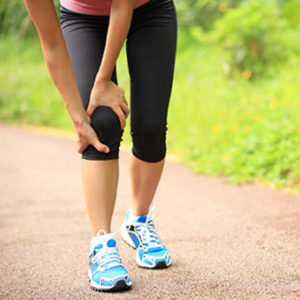 At one point or another, runners eventually ask the question, “Will all that running eventually hurt my knees and cause arthritis so I’ll never be able to run again?”
At one point or another, runners eventually ask the question, “Will all that running eventually hurt my knees and cause arthritis so I’ll never be able to run again?”
The answer is usually no!
When knee pain is ignored, permanent, even crippling damage may occur. By seeking early expert advice and following corrective measures, however, knee pain can often be eliminated without continuous injury.
Proper biomechanical evaluation of the knee, lower extremity and foot can draw attention to the underlying cause of a knee problem. Overuse training, running on unrelenting road surfaces and wearing improper or worn-out shoes are a few possible contributing factors.
Patellofemoral pain syndrome (PFPS) is the leading cause of chronic knee pain in adolescents, and one of the most common causes in adults. Malalignment of the knee joints is not only caused by biomechanical problems in the knee, but more accurately in the entire lower extremity, usually brought on by excessive pronation. An abnormal amount of pronation in the subtalar joint of the foot during the stance phase in running creates an extreme amount of lower leg rotation that disrupts the normal relationship of the knee joint. Remember, this knee joint is riding on a cushion of cartilage only three millimeters thick that must absorb impact three to six times the body weight of the runner. To make matters worse, the knee joint happens to be one of the most unstable in the body, subject to twisting as well as impact injury. Excessive pronation not only causes the foot to roll inwards, but allows the knee to be out of alignment with every stride. The result of this biomechanical imbalance is patellofemoral stress syndrome, or “runner’s knee.”
There are many approaches to runner’s overuse knee pain. The relationship of the pelvis to the knee, and then the lower extremity and foot (referred to as Q-angle) is an important biomechanical consideration. High Q-angle combined with excessive pronation can cause a “pendulum swing” of the knee. Over a period of time, this patellofemoral imbalance can cause articular (cartilage) damage due to increased local stress, and decrease in the amount of normal loading of the articular cartilage.
There are other causes of patellofemoral pain syndrome as well. One of these is weakness or atrophy of the inside quadriceps muscle. Another is wearing shoes where the outer soles are worn down, causing the runner to roll outwards (supinate) excessively during heel strike, then roll in (pronate) excessively. Changing shoes every five hundred miles or every six months is a helpful rule of thumb. Choosing a shoe with good stability and proper motion control is another tip to help avoid this injury.
The use of prescription orthodic devices has been shown to significantly reduce excessive pronation, establish more of a neutral subtalar joint, and allow the foot to function more effectively. The body will then require less forward propulsion, and provide for improved shock absorption. The Q-angle (one of the measures of lower extremity alignment we described) will be altered with a foot orthodic. It has been shown that by altering the Q-angle, a prescription orthodic allows for more normal loading and contact pressure. By affecting the rotations of tibia on the femur, the pressure in the knee joint is more easily distributed between the condyles of the femur. This creates a more normal alignment. Thus, the runner is more biomechanically “correct,” and with the entire lower extremity (femur, knee, tibia, foot) in more proper alignment, the runner suffers less risk of injury.
A less expensive soft orthodic can often work just as easily as the harder prescription device. For the runner who needs minimum control for pronation, the softer device may be all it takes. However, the softer device will eventually break down, and could cause a resumption of symptoms. Therefore, a trial period of at least four weeks is necessary in order to evaluate whether the runner should progress to a more permanent foot orthodic.
Strengthening exercises, particularly of the quadriceps muscle group, is essential. Cross-training exercise – i.e. swimming, aqua-running, cycling, and, later, stair-stepping and roller-blading – can maintain training effect and conditioning, while allowing for rest and recuperation of the knee joint. Another suggestion is taking extra time off between running days. The compulsion to run a marathon, especially two to three a year, can have its destructive affects upon the body, its muscles and joints. When we run every day, we do not allow the body to enjoy the rest it deserves. Often we do not observe the rule to keep weekly mileage increases to 10 percent or less; runners training for marathons often try to boost there mileage during the weekend after too many inactive weekdays. Use cross-training during alternative days to keep in shape, and, simultaneously, give overused muscles and knees a much deserved rest.
The next time you experience a twinge of knee pain with no previous injury, think of overuse runner’s knee and seek the proper sports medicine specialist. Don’t continue to “run through” knee pain.
Prompt treatment and corrective measures now could prevent injury down the road.
Dr. Ross (D.P.M., F.A.C.F.A.S) is a Podiatrist & M.D. in private practice in Houston, Texas. He is also a Clinical Assistant Professor at Houston’s world renowned Baylor College of Medicine and a Fellow of the American College of Foot and Ankle Surgeons. To book an appointment with Dr. Ross or learn more about his services he can be reached at 713.791.9521.
